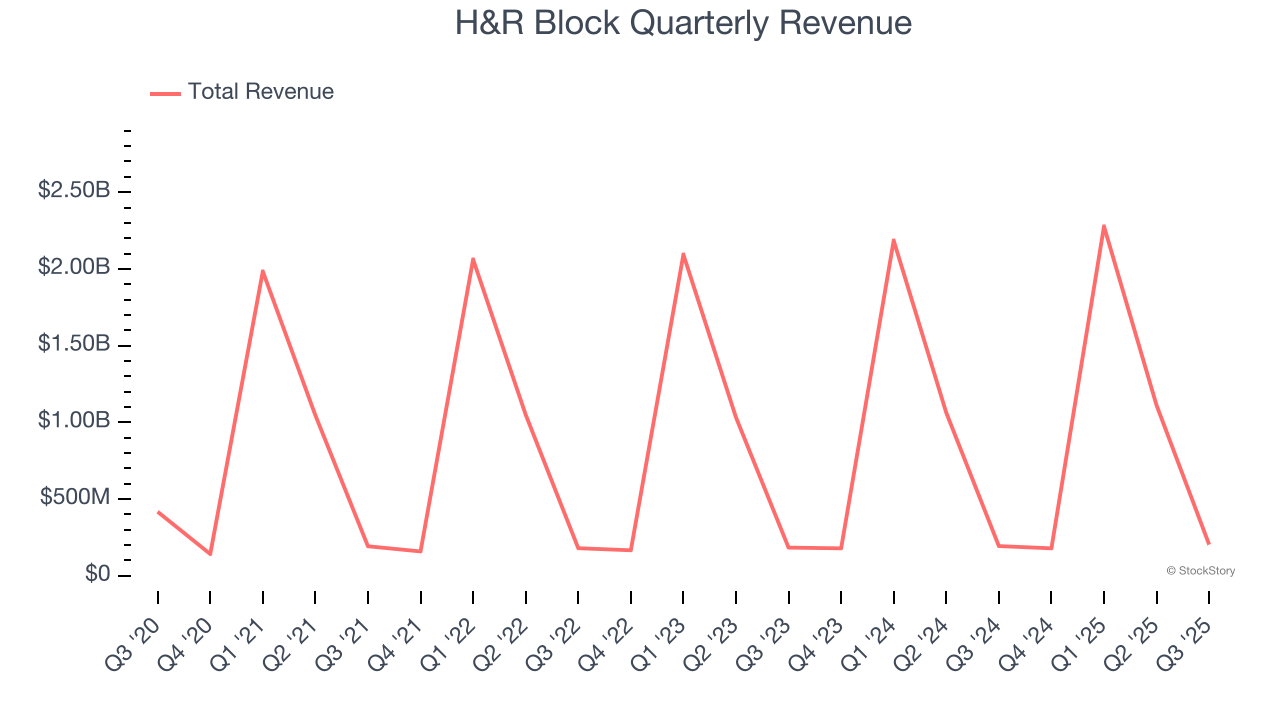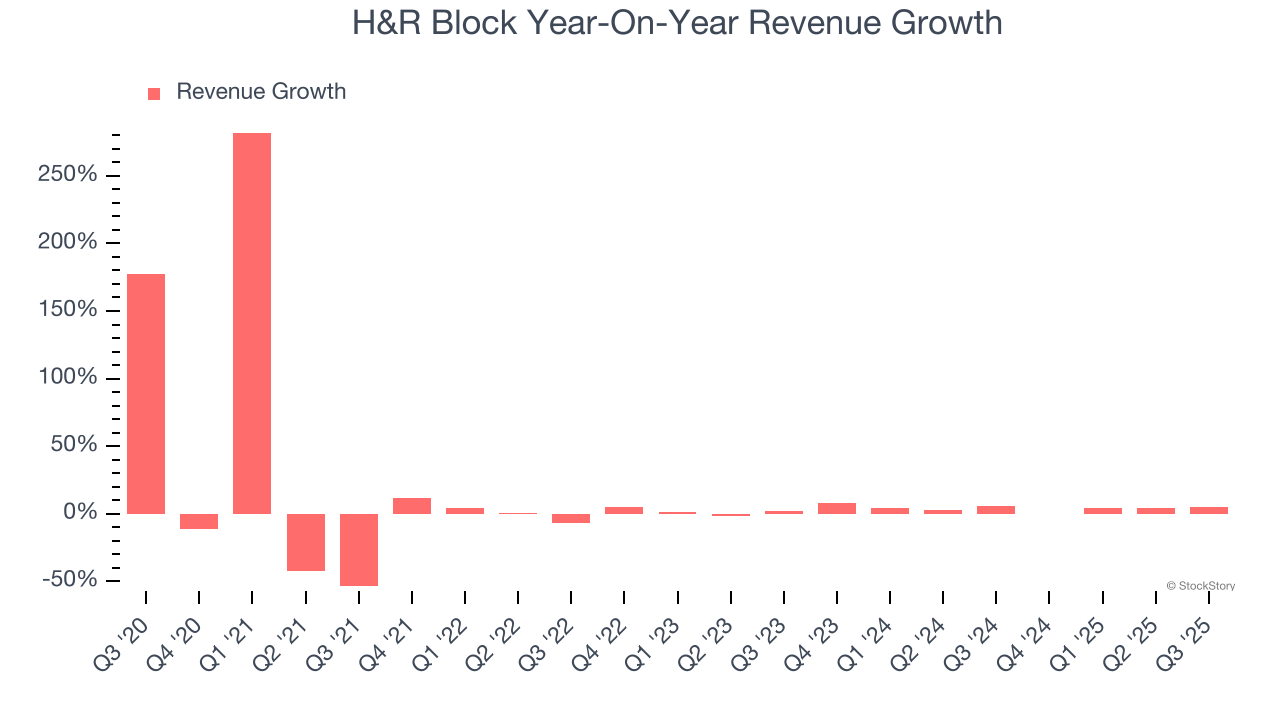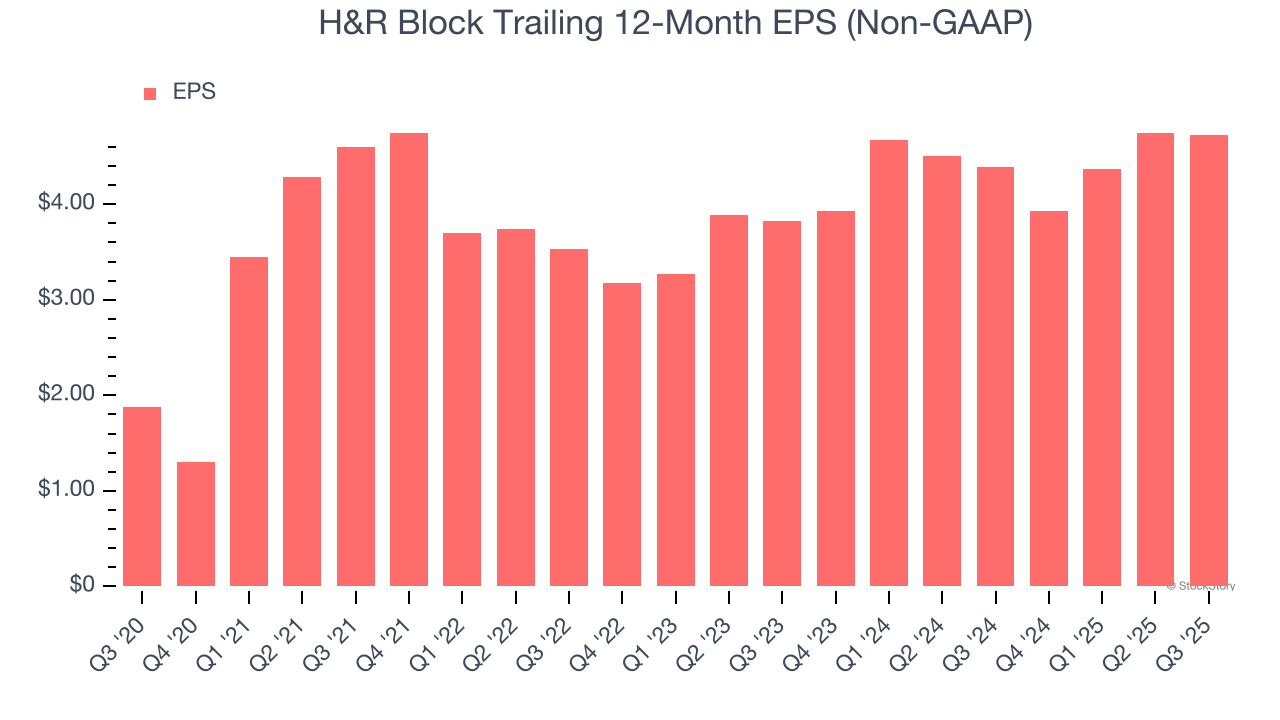
Tax preparation company H&R Block (NYSE: HRB) reported Q3 CY2025 results beating Wall Street’s revenue expectations, with sales up 5% year on year to $203.6 million. The company expects the full year’s revenue to be around $3.89 billion, close to analysts’ estimates. Its non-GAAP loss of $1.20 per share was 11.3% above analysts’ consensus estimates.
Is now the time to buy H&R Block? Find out by accessing our full research report, it’s free for active Edge members.
H&R Block (HRB) Q3 CY2025 Highlights:
- Revenue: $203.6 million vs analyst estimates of $200.6 million (5% year-on-year growth, 1.5% beat)
- Adjusted EPS: -$1.20 vs analyst estimates of -$1.35 (11.3% beat)
- Adjusted EBITDA: -$170 million vs analyst estimates of -$202.8 million (-83.5% margin, 16.2% beat)
- The company reconfirmed its revenue guidance for the full year of $3.89 billion at the midpoint
- Management reiterated its full-year Adjusted EPS guidance of $4.93 at the midpoint
- EBITDA guidance for the full year is $1.03 billion at the midpoint, in line with analyst expectations
- Operating Margin: -106%, up from -118% in the same quarter last year
- Free Cash Flow was -$370 million compared to -$347.3 million in the same quarter last year
- Market Capitalization: $6.47 billion
"Fiscal 2026 is off to a strong start, not only in the financial results we are reporting but also in the plans we are preparing to execute in the coming quarters," said Jeff Jones, president and chief executive officer.
Company Overview
Founded in 1955 by brothers Henry W. Bloch and Richard A. Bloch, H&R Block (NYSE: HRB) is a tax preparation company offering professional tax assistance and financial solutions to individuals and small businesses.
Revenue Growth
Reviewing a company’s long-term sales performance reveals insights into its quality. Any business can put up a good quarter or two, but the best consistently grow over the long haul. Unfortunately, H&R Block’s 5.3% annualized revenue growth over the last five years was sluggish. This was below our standard for the consumer discretionary sector and is a poor baseline for our analysis. We note H&R Block is a seasonal business because it generates most of its revenue during tax season, so the charts in our report will look a bit lumpy.

Long-term growth is the most important, but within consumer discretionary, product cycles are short and revenue can be hit-driven due to rapidly changing trends and consumer preferences. H&R Block’s recent performance shows its demand has slowed as its annualized revenue growth of 4.2% over the last two years was below its five-year trend. 
H&R Block also breaks out the revenue for its three most important segments: Tax Preparation, Financial Services, and Wave Financial, which are 49.2%, 32.3%, and 14.7% of revenue. Over the last two years, H&R Block’s revenues in all three segments increased. Its Tax Preparation revenue (DIY, assisted, add-on services) averaged year-on-year growth of 4.5% while its Financial Services (Emerald Card, Spruce, interest income) and Wave Financial (business software) revenues averaged 74.9% and 10.9%. 
This quarter, H&R Block reported year-on-year revenue growth of 5%, and its $203.6 million of revenue exceeded Wall Street’s estimates by 1.5%.
Looking ahead, sell-side analysts expect revenue to grow 3.2% over the next 12 months, similar to its two-year rate. This projection doesn't excite us and indicates its newer products and services will not accelerate its top-line performance yet.
Software is eating the world and there is virtually no industry left that has been untouched by it. That drives increasing demand for tools helping software developers do their jobs, whether it be monitoring critical cloud infrastructure, integrating audio and video functionality, or ensuring smooth content streaming. Click here to access a free report on our 3 favorite stocks to play this generational megatrend.
Operating Margin
Operating margin is a key measure of profitability. Think of it as net income - the bottom line - excluding the impact of taxes and interest on debt, which are less connected to business fundamentals.
H&R Block’s operating margin might fluctuated slightly over the last 12 months but has generally stayed the same, averaging 22% over the last two years. This profitability was top-notch for a consumer discretionary business, showing it’s an well-run company with an efficient cost structure.

This quarter, H&R Block generated an operating margin profit margin of negative 106%, up 11.5 percentage points year on year. Because H&R Block is a seasonal business, we prefer to analyze longer-term performance rather than one quarter.
Earnings Per Share
Revenue trends explain a company’s historical growth, but the long-term change in earnings per share (EPS) points to the profitability of that growth – for example, a company could inflate its sales through excessive spending on advertising and promotions.
H&R Block’s EPS grew at a remarkable 20.2% compounded annual growth rate over the last five years, higher than its 5.3% annualized revenue growth. However, this alone doesn’t tell us much about its business quality because its operating margin didn’t improve.

In Q3, H&R Block reported adjusted EPS of negative $1.20, down from negative $1.17 in the same quarter last year. Despite falling year on year, this print easily cleared analysts’ estimates. We also like to analyze expected EPS growth based on Wall Street analysts’ consensus projections, but there is insufficient data.
Key Takeaways from H&R Block’s Q3 Results
We were impressed by how significantly H&R Block blew past analysts’ EPS and EBITDA expectations this quarter, as its Financial Services revenue drove the outperformance. Overall, this print had some key positives. The stock remained flat at $51.45 immediately after reporting.
Is H&R Block an attractive investment opportunity right now? If you’re making that decision, you should consider the bigger picture of valuation, business qualities, as well as the latest earnings. We cover that in our actionable full research report which you can read here, it’s free for active Edge members.





